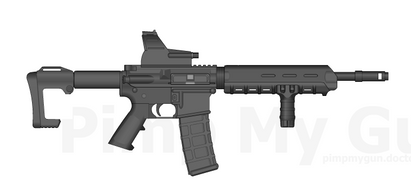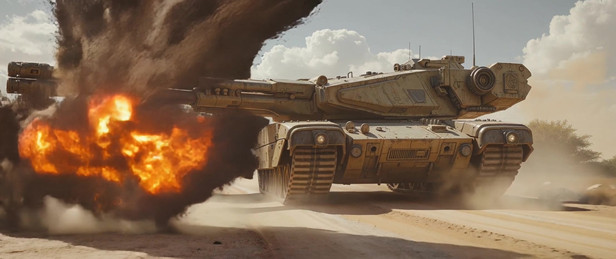HOME | DD
 Basilisk2 — ILAV-AT 'Apocalypse 4-1'
Basilisk2 — ILAV-AT 'Apocalypse 4-1'

Published: 2016-09-22 09:35:38 +0000 UTC; Views: 3868; Favourites: 64; Downloads: 0
Redirect to original
Description
In 2052, the civil war that had been ravaging the former Yuktobanian republic of Khalidistan reached new heights. The Osean 2nd Marine Expeditionary Brigade was deployed in conjunction with the Icarus carrier strike group in hopes of pacifying the autocratic Khalidi government and bringing stability to the region, in addition to securing Osean interests that were threatened by the firestorm raging in the small desert country.Following a daring amphibious landing in late August, the 2nd MEB made rapid progress across the country, devastating the Khalidi forces and pushing them back to their final defensive lines near the capital of Ahmadabad. However, the marines' good luck was not to last. The Khalidis' primary ally, the People's Republic of Verusa, was thoroughly displeased with the idea of a large and thoroughly successful Osean marine brigade so close to their borders. On the 10th of September 2052, Verusan troops surged south across the border, with the intent of pushing the marines back and reestablishing the Verusans "buffer zone."
The 2nd MEB managed to slow the Verusan advance significantly through a number of delaying attacks, in conjunction with effective close air support from the Icarus CSG, but as more and more Verusan forces poured into Khalidistan, the MEB, heavily outnumbered, was forced to retreat to a defensive line near its beachhead. In the retreat, a number of Osean units were cut off from the main force. One of these included the Alpha and Headquarters companies of the 2nd Light Armored Reconnaissance Battalion, nicknamed "Darkseid," which had been raiding behind the Verusan lines to interdict enemy supply lines and relieve pressure on the heavier elements of the MEB. However, due to communications mishaps, the 2nd LAR was cut off. Judging the unit of lightly armored wheeled vehicles to be no threat to the Khalidi and Verusan heavy armor, the combined Khalidi-Verusan forces bypassed the isolated Alpha, or "Apocalypse," and H&S, companies, holding them in place with harassing artillery fire and air support.
While the 2nd MEB certainly had an air cover advantage due to its own organic air wing and the Icarus' air group, this advantage was quickly negated by the introduction of Verusan heavy SAMs. With their ability to maneuver freely severely impeded by Verusan HQ-40 long range SAMs, it was decided that all Osean aircraft in theater should be dedicated to preserving the MEB's beachhead while reinforcements crossed the Ceres Ocean and preventing the 2nd MEB's lines from collapsing outright. The fact that the 2nd LAR's isolated elements were fully underneath the Verusan SAM umbrella meant that close air support was completely out of the question. Additionally, they were too far behind Verusan lines to receive support from the MEB's heavier artillery. In essence, Alpha and H&S Companies were on their own.
Growing increasingly desperate and fed up with their mounting losses from artillery, and unable to utilize OFMC or OFN support assets, 2nd LAR was forced to resort to more unorthodox means to acquire support in hopes of making it back to the rest of the MEB. Using back channel communications that were not being jammed by the Verusans, the 2nd LAR was able to take advantage of an existing relationship of one of the officers in A Company to request air support from Rosenthal, Incorporated.
Bound by In Extremis laws that required the company to provide support to Osean forces in need, Rosenthal promptly assembled a strike package to support the 2nd LAR as it planned to make a break for friendly lines. In an astounding five hours after receiving the request, Rosenthal prepared a package of 2 FB-22 Strike Raptors, call sign "Serpent 11" and "Serpent 12" to support the LAR and even the odds. Despite the fearsome capabilities of the FB-22, the mission would still be immensely complicated. The two strike aircraft would need to fly all the way from Estovakia in the north to Khalidistan in the south, crossing the entirety of the Union of Yuktobanian Republics. Even with Rosenthal's organic aerial refueling capability, provided by a KC-46 Pegasus that would accompany the FB-22s, the flight would require a massive amount of tanker support. Fortunately, the Yuktobanians, displeased with the antics of their southern neighbors but unwilling to commit troops of their own, were more than willing to allow overflights as well as refuelings for the KC-46. However, this did not solve the issue of the Verusan-Khalidi IADS. On this note, it was decided that the Rosenthal aircraft would neutralize the HQ-40s, creating some breathing room for the embattled Osean aircraft while also making their own ingress easier.
Despite the risk, the plan went off smoothly. The FB-22s crossed the border into Khalidistan without incident, and quickly neutralized the HQ-40 site using stand-off supersonic cruise missiles. With the long range SAM threat negated, the FB-22s made contact with the surprised AWACS in theater as well as the elements of Darkseid, and began to move in support of their assigned tasking. Engaging with powered anti-armor Joint Standoff Weapons, the FB-22s damaged or destroyed a large amount of the heavy armor facing Apocalypse Company, leaving the Khalidis with their significantly lighter armored APCs and IFVs, which could be much more feasibly engaged by the Bushmaster IIs of the LAR's ILAV-30s. Their primary objective complete, Serpent 1 and 2 broke off to destroy a division level command post they had detected on their way to support Darkseid, thereby disrupting the opposing forces even further.
As A Company began its advance, the FB-22s remained on station, delivering GBU-60 Small Diameter Bombs on any targets threatening the push. With the effective fire from the FB-22s, as well as its own weapons platoon, A company was able to punch a hole through the Verusan lines. The sudden gap caused the Verusans to wheel to attempt to meet the threat, providing the 2nd MEB's heavy forces an excellent flanking opportunity. As the Osean units coalesced, they gave the Verusans and Khalidis a taste of their own medicine, so to speak, first encircling, then smashing the Khalidi unit that had been caught in the impromptu pincer.
The daring endeavor was not perfect, however. Apocalypse suffered heavy losses, with one platoon of ILAV-30s being wiped out completely, and the weapons platoon losing 2 of its 4 ILAV-ATs, one to a Khalidi T-14MS a few days prior to the breakout, and another to an effective burst of autocannon fire during the breakout attempt.
Despite this, "Darkseid's Miracle," as it came to be called, was hailed as a brilliant example of cooperation between PMC and national armies, as well as a classic underdog tale. Soon after the breakout, relief elements from the 1st Marine Expeditionary Brigade as well as the Osean 25th Cavalry Division arrived in Khalidistan, forcing the Verusans to retreat. With their ally's support lost, the Khalidis quickly folded under the Osean onslaught, and by December, a cease-fire was declared.
Darkseid was not the same after "The Shitfest," as it came to be known within the unit, with a large number of personnel choosing to leave the unit or the Marine Corps entirely to avoid a nightmare such as the one they had experienced in the desert.
The ILAV-AT depicted above, "Batmobile," is the personal mount of Apocalypse 4 Actual, First Lieutenant Ben Morgan, the commander of A Company's weapons platoon and a die-hard DC Comics fan. Batmobile wears a disruptive brown camouflage pattern that was painted over the standard desert sand color at the suggestion of Lieutenant Morgan, whose idea was quickly adopted by the rest of A Company. While the end result of the pattern meant that the vehicles of A Company blended in surprisingly well with the sand and rocks of the Khalidi deserts, the original reason for the scheme was significantly more trivial, as Lieutenant Morgan felt the pattern made the Strykers resemble the original Tumbler from the classic superhero film "Batman Begins."
"Batmobile" is shown here as it appeared upon its return to Marine Corps Base Camp Henderson on the west coast of Osea. The vehicle sports twelve kill markings, five tanks and seven light armored vehicles, scored during the conflict. The rear ramp of the vehicle bore the names of those lost in the two ILAV-ATs that were destroyed during the encirclement and breakout. Additionally, the auxiliary rear-view mirrors were mounted, as the vehicle's rear-view cameras suffered shrapnel damage during one of the many artillery barrages the 2nd LAR suffered.
The owners of the properties depicted herein and myself maintain their respective rights.
Do not use this artwork without my express permission.
Icarus CSG created by Ronin201 .
























